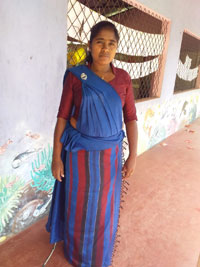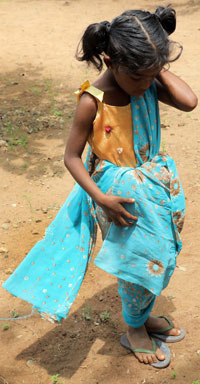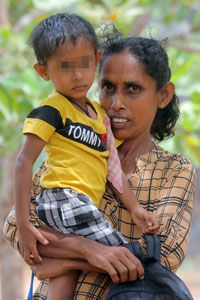A Brief Colonial History Of Ceylon(SriLanka)
Sri Lanka: One Island Two Nations
A Brief Colonial History Of Ceylon(SriLanka)
Sri Lanka: One Island Two Nations
(Full Story)
Search This Blog
Back to 500BC.
==========================
Thiranjala Weerasinghe sj.- One Island Two Nations
?????????????????????????????????????????????????Monday, June 27, 2022
Sri Lanka: Starvation stares in the faces of their daughters and sons
By Kumudini Hettiarachchi -25/06/2022
The children are starving!
If remote Salalihini-gama close to Bogaswewa, about 22km from Vavuniya town, is a ‘microcosm’ reflecting Sri Lanka’s tragedy as it falls deeper into an economic morass exacerbated by a food and fuel crisis, it is obvious that the country’s children are starving.

Anushka-new
Pre-school teacher Anushka Chandani Tennakoon
Single-parent Chandra Kanthi (31) is toiling to bring up three children – two daughters aged 11 and 6 years and a son who is 5. To maintain the family’s less than hand-to-mouth existence, she goes around the village looking for backbreaking udulu gana weda (land clearing work).
What did she give her children to eat that morning? With eyes cast down, she mumbles that she gave them a rotiya. The tears flow and the non-forthcoming answer is obvious when asked what she ate…….nothing!
Another heart-rending insight into these villagers’ lives comes from S.K. Ravindrawathi (41) who is carrying Gautham Gimhana Rupasinghe just four years old. The youngest of four siblings, his eldest brother (24) is doing carpentry in Colombo. He used to send a little money but now he does not have work. Gimhana’s twin 22-year-old brothers have married and moved away from home, while his sister (17) has just sat the Ordinary Level examination.

Sajani-Rangika
Sajani Rangika
Skeletal and gaunt, Gimhana’s weight should be between 14-18kg but he is only 9kg 900gm. The Vavuniya Hospital staff wants the parents to feed him up but their vegetable cultivations have been severely hit by the shortage of thel pohora (fertilizer).
Life is tough – they are trying very hard to nourish Gimhana. He loves rice but meats such as chicken (at Rs. 1,300 a kilo) to give only their son are beyond their meagre means. A biththara gediya (egg) is Rs. 45 and they can ill-afford it. So they manage with papaw and guava from their garden and mallun made of manioc and passion fruit leaves.
Ravindrawathi says how last weekend they bought mango and pineapple from town and headed to the Dambulu Viharaya, a distance away, with Gimhana in tow, to try and make a few hundred rupees as profit. What the child would have eaten on the journey is anybody’s guess.
Pre-school teacher Anushka Chandani Tennakoon has 21 little wards, both girls and boys below five years of age under her care. Except a few whose families are doing okay, many are struggling to keep starvation beyond their humble doors.
She sees the children open their food parcels and while some would eat a little rice and thel-daapu kehel muwa or mallun of green leaves from their gardens, many would slink out to play without a bite. Triposha has not been distributed to these families for a very long time.

Ravindrawathie-with-Gimhana-01
Ravindrawathie with Gimhana
What of wew-maalu (tank fish) and the answer is that it is simply too expensive – a kilo of teppili costs a princely Rs. 360. An egg is Rs. 35 or more, a kilo of kadala parippu more than Rs. 300 and most children do not even see a touch of milk, let alone a cup of milk. One or two mothers would buy a chooti packet of milk and “colour” the tea for the little ones to see there is milk.
“A very few have made good as their vegetable cultivations and fruit trees are bearing but they too are facing issues in transporting them to markets. A majority though are eking out a living through kuli weda (working as labourers) and some families are women-headed households as their husbands have long departed, leaving behind several children as well,” she says.
Anushka says that it is difficult for some to cultivate the land allocated by the government when they were settled here – even though there are wells and tube wells. The single women especially have no one to help them. For the families living in slightly hilly terrain, water too is a problem and some carry containers about 1km away to get drinking water, while others pay Rs. 2 a litre for filtred water.
As part of her work, she weighs each child under her care regularly and finds that their weights seesaw – sometimes going up by 50gm but often dipping by 100gm.
Considered the village’s ‘institutional’ memory, cultivator Kumara Herath one of the early settlers in the area since 2013 says that Salalihini-gama falls under two Grama Sekava (GS) wasam, coming under Vavuniya North and South. It has 518 families.
The settlers, with promises of greener pastures in Salalihini-gama, arrived from the four corners of Sri Lanka. They were allocated one acre each of goda idam. State agencies, non-governmental organizations and charitable organizations aided the settlers to build their homes and also secure water sources such as wells and tube wells.
Kaleena govithem such as wattakka, mae karal and bandakka, Herath does to keep his home fires burning, while also having a small paddy-field. It is a hard life, he concedes as being in the dry zone, it rains only for about four months of the year. It is then that people can do their cultivations and earn some money. When there is no rain, some do monava hari govithen (some sort of cultivation) in podi paaththi (small plots).
In both GS divisions, 321 of the 518 families (more than half) are on Samurdhi, more are waiting to get on the list and a handful are state workers. The Samurdhi recipients fall into three categories – if it’s a family of two, their monthly allowance is Rs. 1,250; if three it’s Rs. 2,500; and if four or more it’s Rs. 3,500. However, Rs. 250 gets deducted for insurance and other stuff from each slab, says Herath.
According to him the village is also in the grip of many social issues with husbands deserting wives and vice versa. Very few families have one or two children, with a majority having 3, 4 or 5.
He points out that there is no primary school in the village and the children have to travel 10km to the closest one, with the bus fare being Rs. 70 one way and parents simply do not have that kind of income to spend Rs. 140 a day per child for the journey to and back from school. Therefore, the chances are high of extensive school dropouts and his suggestion is that the authorities should arrange a school bus to overcome this.
Referring to the health of the children, Herath adds that earlier if 10% were affected by malnutrition, currently it would be about 30%.
For H.M. Sandamali Harsha (23), starvation staring her little daughter, Sajani Rangika (5) in the face is not the only problem.
While her husband has gone in search of work to Colombo as a labourer, she worries that she cannot feed Sajani whose weight is 14kg. It is mostly mae-karal from the garden and buth that she gives her even though doctors have told her to “feed up” Sajani with at least one egg a day and also meats and mallun.
Sajani had been diagnosed with a thin blood vessel in the chest, most probably linked to her heart. It was when they were living in their hometown of Walapane, Nuwara Eliya that they noticed that Sajani’s chest was protruding and took her to the hospital from where she was referred to the Peradeniya Hospital.
Sandamali says that as they are settled in Salalihini-gama, their Samurdhi “eka kapala” (cut) and she is going back and forth to Walapone at great cost to get that sorted out.
Accessing food is posing a problem because they are not living in a town. To get rice at Rs. 200, she has to travel to the Sathosa which is in Vavuniya. Dhal is Rs. 600, piti-kiri ganna wath kamak ne and a kilo of korali (tank fish) is an exorbitant Rs. 500.
How can they feed their children, is the lament of many a mother in Salalihini-gama. If these hapless families have been in the jaws of poverty earlier, now they are in the vice-like grip of starvation.

